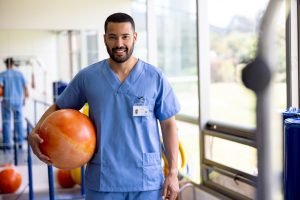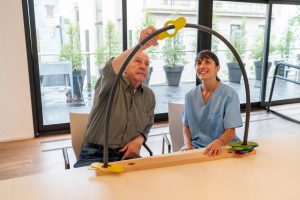OTA School: An Occupational Therapist Assistant Curriculum
Published - May 24, 2024

What Do You Learn During an OTA School Program?
During the OTA school program, you will complete the general education, healthcare, Psychology, and laboratory procedure curriculum. These courses include:
Anatomy and Physiology
This course prepares OTAs with knowledge of body systems, organs, tissues, and cells, with a focus on major biochemical, molecular, and cellular biology theories.
Introduction to Psychology
An introduction to general psychology and human behavior focusing on mental processes and personality development.
Medical Terminology
This course focuses on basic word structure, anatomical terms, and terminology used by occupational therapist assistants. It also includes the correct pronunciation of medical terms.
Occupational Based Practice
A review of the role of an OTA in the lives of persons, groups, and populations of all ages. School instructors help students through class discussion, self-study, reflective writing, and participation in group projects.
Clinical Conditions and Applications
An overview of systemic disorders and clinical conditions related to occupational therapy. School instructors support students with patient care skills, vital signs, CPR, and other emergency procedures and responses.
Occupational Performance
A review of factors that influence general health that specialize in the following areas:
- Psychosocial/Mental Health – an introduction to mental disorders, medical, psychological, and sociological factors that influence general health.
- Pediatric/Adolescent – a focus on occupational therapy theory and practice from birth through school age and young adulthood. School instructors incorporate the Person-Environment-Occupational Model and evidence-based practice into the treatment learned during the curriculum.
- Adult/Older Adult – an introduction to occupational therapy for adults and older adults.

Two courses that analyze human occupations and motion. These courses review the practice of activity analysis, adaptation, modification of activities, biomechanical forces on the body, concepts of locomotion, forces, and levers.
Experiential Lab Procedures
An interactive lab supervised by school instructors to introduce the foundations of clinical practice, basic clinical skills, and offer an introduction to basic human movement. Emphasis is placed on processes, communication skills, documentation, assessment, and intervention strategies.
Fieldwork
This OTA school module offers students a supervised clinical experience with two concurrent weeks of full-time clinical education. This includes observation and application to help students develop a basic comfort level with occupational therapy patients’ needs.
Therapeutic Applications
School instructors offer a review of ergonomics, essential environment modifications, and practical alterations to equipment.
Capstone
Preparation for the National Board for Certification in Occupational Therapy (NBCOT) exam, test-taking skills, and a review of content-based exam questions.
OTA School Program
You’re already making a difference through the work you love. Now, take it to the next level with the Occupational Therapist Assistant program from CBD College. It’s flexible, affordable, and uniquely tailored to build on the skills and experience you’ve acquired professionally.
Contact us now to learn more.



